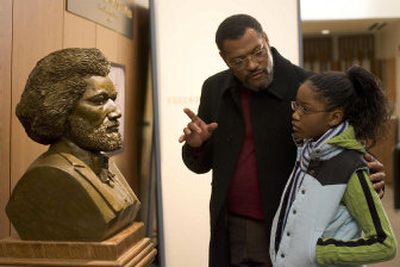Buzz about the bees

Who could have guessed there was this much drama in somebody trying to spell chrysanthemum?
Er, chrysanthamum.
Er, chris …
Never mind.
It wasn’t so long ago that spelling bees were nobody’s idea of a good time.
Well, almost nobody. Arnold, the geeky kid with glasses who could not only spell ratiocination but use it in a sentence, thought they were just fine. But he was more likely to be a target of physical abuse than a hero of stage and screen.
But that was before the 2001 novel “Bee Season,” the 2002 Oscar-nominated documentary “Spellbound,” the 2005 Broadway musical “The 25th Annual Putnam County Spelling Bee,” the 2005 movie version of “Bee Season” and the new movie “Akeelah and the Bee,” turned spelling bees — already a low-level phenomenon through the yearly ESPN broadcasts of the Scripps-Howard National Spelling Bee — into a national obsession.
Now Arnold is a luminary. Er, lumanery.
Er, star.
“It’s an American cultural phenomenon,” says Rachel Sheinkin, who won a Tony for the book she wrote for “Putnam County Spelling Bee.”
Other countries have no idea what we Yankees are up to when we ask children of nine to spell sesquipedalian in 10 seconds. In Australia, Sheinkin says, audiences found the down-under production of “Putnam County” exotically American.
“They didn’t know what to make of it in Melbourne,” Sheinkin says. “They loved it, and they made it their own. But they did not fully have a sense of competitive academics.”
The key word is competitive. C-o-m-p-e-t-i-t-i-v-e. Competitive.
America, famously, is a competitive country — as every awkward kid who was ever picked last for the team knows too well.
The 19th century schoolmarms who invented the spelling bee (the term, possibly related to “quilting bee,” first appears in print in 1825) probably had no intention of playing Vince Lombardi to six generations of class brainiacs.
They were just looking for a congenial way to reinforce the lessons of Noah Webster’s popular spelling books, first published in 1786.
Likewise, the Louisville (Ky.) Courier-Journal was probably just looking for publicity when it created the National Spelling Bee in 1925 — later co-opted, in 1941, by the Scripps-Howard chain.
How could they know that they were planting the seeds for what would become, in the fullness of time, America’s biggest Revenge of the Nerds scenario?
“This is the chance for the nonathletic kids to have their moment,” Sheinkin says. “It’s the kids who don’t get picked first in gym who are up there.”
Kids like Charlie Brown, who in his first feature film “A Boy Named Charlie Brown” (1969) competes in a national spelling bee.
But it was the Bush administration, with its emphasis on competitive academics and standardized tests, that probably set the stage for the astonishing reemergence of the spelling bee as a pop craze.
Everyone, these days, loves a spelling bee.
“You have continual suspense, unfolding letter by letter,” Sheinkin says. “You have all these ups and downs in your characters’ fortunes. Success or failure is only seconds away, and it’s in their own hands. You have character and action built right in.”
There’s the weird, geeky genius, full of nervous tics. There’s the kid-under-pressure from his parents or from himself. There’s last year’s winner, who may or may not maintain his title. And of course there’s the underdog, the kid from the wrong side of the tracks.
That’s the tack that “Akeelah and the Bee” takes in its story of an 11-year-old South Los Angeles girl (Keke Palmer) for whom the National Spelling Bee may be a ticket out of the ghetto.